| Introduction
The majority of unwanted organic wastes found in our aquariums
collect at the surface of a gas-liquid interface. These "surface-active"
materials, including fish wastes, uneaten food, and decomposing
matter are what we attribute to increasing our tanks pollution.
We associate this extra waste with increases in nuisance algaes,
cyanobacterial blooms, and having a generally unhealthy tank
appearance. Therefore, when we add new fish, and/or increase
the volume of foods in our tank, we hope to remove an equal
amount of potential pollution. The good news is we can reduce
some of these potential wastes by removing them from the water
before they cause problems. One method of removing organic wastes
from a fish tank is through foam fractionation (skimming).
The protein skimmer originated in the wastewater
treatment industry many years ago. It was used primarily to
reduce the organic load before the water reached the activated
sludge reactors. This technique exploits the affinity of organic
waste to adsorb to air bubbles. In basic terms, organic-waste-laden
aquarium water is reacted in a column of air bubbles, the
waste sticks in the foam, and the foam collected. Foam is
what is produced when one passes a gas through a liquid that
contains high levels of surfactants.
In the following sections of this article
I would like to explore the basics of protein skimmers (also
known as foam separators, foam fractionators, or air-strippers),
discuss why foam fractionation works, and describe a few of
the current skimmers which are commonly available to the hobby.
So what are we
trying to remove?
Fish poop, of course. Honestly, proteinacious waste only makes
up a small portion of what we are trying to eliminate. According
to Millero [1], the concentration of proteins found in natural
seawater (as amino acids) is about 0.02 to 0.25 ppm (20 to
250 ug/l). These make up 2-3% of the dissolved organic compounds
found in our tank water. However, data presented by Shimek
[2] in which 23 hobbyist's tanks were surveyed reported protein
concentrations of 0.00+ 0.00, suggesting that these tanks
were devoid of any detectable proteins. Other organic wastes,
which are more readily detectable, are primary and secondary
amines, some amino sugars, alcohols, and fatty acids. Lipids
(fats) were measured at 1.361 ± 0.940 ppm with a maximum
of 3.20 and a minimum of 0.00 in the same study [2]. So, then,
what are protein skimmers removing? More importantly, why
do we even call this device a "protein skimmer"
when there's no protein to remove?
Dissolved Organic
Compounds (DOCs)
DOCs are the waste molecules skimmers are designed to remove;
these are produced as byproducts from the breakdown of biological
materials. This pollution arises from not only the deliberate
input of foods in our tank but also from decaying organic
matter (bacteria, algaes, etc). DOCs are bipolar molecules;
these surfactants are attracted to air/water interfaces, i.e.,
bubbles. A bipolar molecule contains one or more atoms attracted
to air, and one or more atoms attracted to water. A skimmer
exploits this difference in the following manner:
"As an air bubble moves through
the column of organic-laden water, the electrically charged
protein molecules (which contain electrically polar and electrically
nonpolar regions) are attracted to the air/water interface
of the bubble. The polar regions of the molecule (made up
of nitrogens, oxygens, etc.) are attracted to the air/water
interface and these polar "tails" stick out away
from the air bubble into the water column. The nonpolar regions
stick out into the air bubble because it does not "like"
to be in contact with the polar solvent (i.e. water). If you
could look at this bubble under high enough magnification
down to the molecular level, the entire air bubble would look
like a fuzzy ball with protein tails and other electrically
charged tails sticking out from the surface of the air bubble.
The polar regions outside of the air bubble stabilize the
air bubble very much like a soap bubble in your kitchen sink
or your washing machine. This is the reason why foam begins
to build up at the surface of the skimmer. As the protein-laden
bubble reaches the top of the protein skimmer, the proteins
begin to accumulate which creates a stable foam bubble. These
stable foam bubbles take a long time to pop. Thus, the proteins
slowly are concentrated at the top of the skimmer where they
are slowly pushed through the "throat" of the protein
skimmer and into the collection cup."
This description, written by Shane Graber, can be found in
its entirety here.
The longer that the DOCs are in contact
with the bubbles, the more of them will attach to the bubbles,
the more of them will be removed. Longer contact times allow
for less adherent molecules to be attracted and "stuck"
to an air bubble. Other compounds besides DOCs can be removed
as well. These may be VOCs (volatile organic compounds), POC
(particulate organic compounds), uneaten fish food, trace
elements, secondary metabolites from soft corals, bacteria,
macro- and micro-planktons, coral eggs and sperm and other
similar compounds.
Okay, so how do
we make a protein skimmer?
Theoretical concerns VS reality
If a foam fractionator were constructed in its simplest form,
it would look like a tall tube in which tiny air bubbles are
injected into the bottom center. Waste laden water would be
pumped into this tube with the intent of the waste adhering
to the air bubbles. If you recall in the above DOC section,
air bubbles act as an adsorbent, and waste molecules are attracted
to this adsorbent and are removed from the water column as
foam. With this description, let's explore the parts of a
simple skimmer.
A skimmer has at least three parts:
| 1. |
The skimmer body, where
most of the contact between the DOCs and water takes place. |
| 2. |
The foam separation area,
or riser tube, where the organic laden foam is separated
from the water. |
| 3. |
A collection cup, where the foam spills
over the riser tube and is drained away.(image below)
|
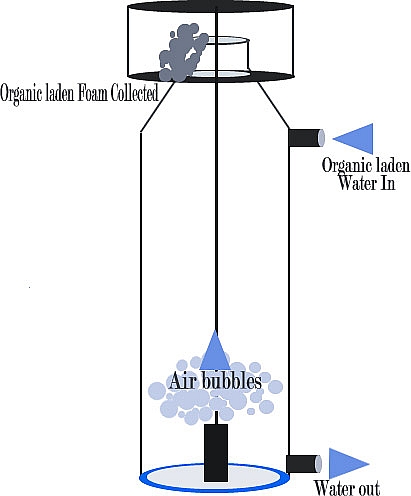
The above description can take many shapes and forms, and
the myriad of hobbyist skimmers available on the market suggests
this is true. However, my basic description above doesn't
look like many of the skimmers on the market today, and this
is where hobbyists get confused. With so many skimmers on
the market, which one is the "best one" for their
tank? The bottom line is there is NO one best skimmer. Many
hobbyists are looking for the perfect skimmer, one that will
remove all the organic waste in the tank water, a skimmer
which is compact in size, inexpensive to run, and requires
virtually no maintenance. In reality, what skimmer to use
is truly a guessing game. What we do know is that different
skimmer designs equate to different levels of effectiveness
at removal of waste. The confusing part comes when hobbyists
are confronted with manufacturer's advertising, claiming their
skimmer is superior over all the rest because of some 'new'
skimming technology. Claims such as, "The "Cycloskim2000"
which is 18" tall, will easily skim your 100gal fish
tank, and only requires 1 watt of electricity to operate,"
are rampant in manufacturer's advertisements. So, how do we
separate what's truth and what's advertising? For me, one
of the least complicated ways to understand which skimmer
to buy is to understand a few of the theoretical basics of
skimming and then apply this theory into functional reality.
In chapter 9 of the textbook Aquatic Systems Engineering:
Devices and How They Function, P.R.Escobal 2000 [3] Escobal
presents a few theoretical concerns that should "shape"
the efficiency of a skimmer. These are presented in original
form in Table #1.
| 2nd Law: |
The bombardment rate (number
of times a clean air bubble bumps into a drop of water)
depends on the duration of the tank water exchange and
the diameter of the skimmer. |
| 3rd Law: |
Increased skimmer length
or height only raises the value of the absolute contact
time but does not affect the bombardment rate. |
| 5th Law: |
The airflow rate entering
a skimmer should produce a full upward blossom of bubbles
without excessive turbulence, and is theoretically determined
as a function of skimmer diameter, length, bombardment
rate and absolute contact time. |
| 6th Law:
|
The value of bombardment
rate within the skimmer, its length, diameter and airflow
must all be properly chosen for optimum operation. |
Table #1
Simplifying and summarizing these "skimming laws"
allows us to focus our efforts to ensure we have optimal skimming
(Table #2). This is a list of concerns, and there are four
parameters that need to be addressed.
|
Skimmer Design
Concerns
|
•
|
The water flow rate
through the skimmer |
|
•
|
The height of the
skimmer |
|
•
|
The amount of air
pumped into the reaction chamber of the skimmer |
|
•
|
The diameter of
the skimmer |
|
Table #2
| 1) |
For optimum skimming,
water flow thru the skimmer should be sufficiently slow
as to allow interactions of an air bubble and organic
waste. The best designs for this are skimmers that
employ water moving against the flow of bubbles. These
are called counter-current skimmers. However, slow is
a relative term. |
| 2) |
Make the skimmer reaction
chamber as tall as possible to maximize the contact time
that the water has with the air in the skimmer. Pump as
much air into the reaction chamber as possible.
The key to injecting air is twofold: a) maintaining the
smallest sized air bubbles, and b) reducing any potential
turbulence of the air bubbles in the skimmer reaction
chamber. |
| 3) |
The diameter of the
skimmer must be increased in proportion to the amount
of water being skimmed. The larger the amount of water
to skim, the wider the diameter of the skimmer should
be. |
Remember that these are theoretical concerns;
and often a theory is just that, a theory. Reality is often
times different. As an example, let's assume that you want
to build the most efficient skimmer for a 100 gal-reef tank.
Using the skimming laws above, the skimmer should have a five
to six foot tall, eight inches wide reaction column, with
a turnover of two tank volumes/day. It would have dense thick
foam consisting of 0.2 to 0.5mm bubbles, injected in a counter
current fashion against the water entry. So, while this might
be the most efficient skimmer, it is also, in my opinion,
impractical for many hobbyists. This is where we can put aside
the theory as directly written and understand some real world
examples.
Can sufficient skimming be achieved by
using a shorter, thinner skimmer or one that has a higher
flow rate? Yes. Will it be as efficient as our theoretically-defined
skimmer above? Maybe not, but it will be sufficient for the
needs of many hobbyists. Manufacturers of skimmers have gone
to great lengths to optimize their skimmer function and even
though many of the above "skimming laws" are not
met at face value, their skimmers work efficiently. In attempting
to bypass tall reaction column heights, manufacturers have
devised clever ways to lengthen the reaction time: the use
of triple pass flow, and downward air injection tubes of equal
length to reaction tubes which thereby effectively double,
or triple, reaction column lengths. Water swirling patterns
will also effectively increase reaction times. To maximize
bubble density, manufacturers have incorporated air-injecting
spray heads, venturi valves, and other foam generating heads
(such as a Beckett valve) into their designs. The use of a
foaming head effectively removes the requirement for airstones
and an air pump. When matched to a powerful water pump, many
of these foaming heads produce much larger quantities of air
than any airstone/air pump combination can achieve.
Quote: "If
you study Escobal, you will find that residence time, diameter
and air volume all have effects on skimmer operation. Nothing
in his book explains why the Hot-1 works at all, but users
like it." CWA46, Nashville, TN.
Let's examine a few of the skimmer types
available on the market today and how they are optimized to
skim efficiently.
 Air
driven counter-current (CC) skimmers Air
driven counter-current (CC) skimmers
Air driven skimmers are the original type of skimmer designed
for the home aquarium, and fortunately they are one of the
most efficient. However, they also require the most frequent
maintenance, and can be costly. These skimmers use wooden
air diffusers and a powerful air pump to produce their bubbles.
These skimmers have excellent foam volume and consistency
when operated with new (unclogged) airstones. According to
Theil [4], the minimum recommended height of an air driven
CC skimmer is 28", and this skimmer should have two to
three air woods (airstones) for every 4" of skimmer width.
Therefore, a 6" diameter skimmer should have four to
six air woods. Depending on the organic load of the tank,
airstones should be replaced monthly to every two months,
and air pump diaphragms checked and replaced when weakened.
His reasoning for a minimum height of a CC skimmer is due
to the fact that the water and air bubbles must interact over
a set distance and time, and a skimmer shorter than 28"
does not meet these criteria. Long-time hobbyists consider
this skimmer type to produce the most consistent quality foam.
Interestingly, this skimmer style strictly adheres to our
"skimming laws," and when tuned properly it seems
to yield the best results. This is a common skimmer for DIY'ers,
as this skimmer is easy to construct and requires minimal
construction skills.
Venturi skimmers
A venturi skimmer uses a venturi injector to create air bubbles.
These skimmers tend to be shorter than air driven CC skimmers,
and require a powerful pump to drive the venturi valve. For
an explanation of how a venturi valve works, see the explanation
box found in this article [5]. One reason why venturi skimmers
are often utilized in home aquariums is that venturi valves
produce tremendous amounts of bubbles. One of the more common
venturi injectors is a Mazzei®
injector  (image
right). When matched with a high performance pump, these injectors
create large volumes of fine bubbles. The bubble quality tends
to be very good, and this aerated mixture is often injected
into a reaction chamber in a swirling fashion to maximize
contact times. A 1" Mazzei® injector can pull up
to 240cubic ft/hr of air. The Lifereef
VS2 is an example of a skimmer which utilizes this injector.
Another type of (image
right). When matched with a high performance pump, these injectors
create large volumes of fine bubbles. The bubble quality tends
to be very good, and this aerated mixture is often injected
into a reaction chamber in a swirling fashion to maximize
contact times. A 1" Mazzei® injector can pull up
to 240cubic ft/hr of air. The Lifereef
VS2 is an example of a skimmer which utilizes this injector.
Another type of  venturi
skimmer is a Beckett-head skimmer. The Beckett foam generating
spray head is designed for increasing the amount of air that
is mixed into the water. Skimmers incorporating a Beckett-head
often utilize the Beckett in a higher position than the water
level and this extra distance allows for an increase in reaction
time. Additionally, manufacturers have begun to tangentially
inject aerated water into swirling patterns, which also increases
contact time. What is most obvious with a Beckett-head is
the density and consistency of the foam; it far exceeds any
of the other current aeration strategies. The Precision Marine
BulletXL skimmer is an example of one utilizing this injector(image
left). venturi
skimmer is a Beckett-head skimmer. The Beckett foam generating
spray head is designed for increasing the amount of air that
is mixed into the water. Skimmers incorporating a Beckett-head
often utilize the Beckett in a higher position than the water
level and this extra distance allows for an increase in reaction
time. Additionally, manufacturers have begun to tangentially
inject aerated water into swirling patterns, which also increases
contact time. What is most obvious with a Beckett-head is
the density and consistency of the foam; it far exceeds any
of the other current aeration strategies. The Precision Marine
BulletXL skimmer is an example of one utilizing this injector(image
left).
Downdraft™ skimmers
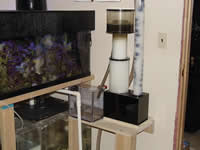
The downdraft™ skimmer is designed quite differently
from all other skimmers; it utilizes a jet of water sprayed
at high velocity into a column containing bio-balls. This
column contains media that effectively disrupts the jet spray
and forms bubbles. After the bubbles flow through this "bioball
column" they enter a sump box, and are deflected upwards
to the foam collection riser in the neck of the skimmer.
In this skimmer configuration, the lengthy water path through
the bioball column, across the sump, and up through the neck
of the skimmer, effectively increases the reaction time. Additionally,
the disruption of the jet spray results in copious amounts
of bubbles and foam. These skimmers require a very powerful
pump to run correctly, and tend to be fairly large units.
A skimmer incorporating this design is the ETSS®
Gemini 800.
Aspirating impeller skimmers (Air Shredding)
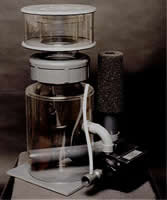
This style skimmer offers a unique twist on an inexpensive
aeration system. Essentially, directing air into the impeller
cavity of a powerhead or small pump creates bubbles. The regular
impeller (Figure #7b below top), a specialized needle wheel
(Figure #7c below left), or pegged wheel (Figure #7d below
right) then finely chops up these air bubbles into very fine
bubbles like those found in an airstone driven skimmer. These
units are unique in that they have a very slow water flow,
generate large amounts of foam, and are cheap to run because
they use low power pumps. A concern which has arisen with
these skimmers is the durability of these specialized impellors.
Because these needlewheel impellors place the weight load
on the periphery of the impellor (and not close to the central
shaft), these impellors have higher failure rates than do
normal vaned impellors. Two skimmers that utilize specialized
needlewheels are the Turboflotor 1000 and the Euro-Reef.
A skimmer that utilizes a traditional impellor in an air shredding
strategy is the German Klaes Skimmer, which is reviewed here.
|
|
|
(Figure #7b)
Regular impeller
|
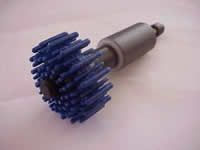 |
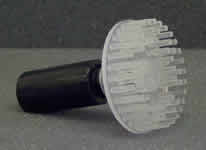 |
|
(Figure #7c)
Specialized needle wheel
|
(Figure #7d)
Pegged wheel
|
|
To Summarize the Current Skimmers:
Air driven counter-current: low water flow, good foam
production (with new air stones), good bubble size, maximum
contact times (with taller units), frequent maintenance and
requires frequent water height adjustments (called tuning).
Venturi: good water flow, good foam production, moderate
contact time, requires a powerful pump, valve tends to clog
(Lifereef has a self-cleaning venturi
valve).
Beckett-head skimmer: high water flow, maximum bubble
production, moderate contact time (swirling patterns will
increase this), requires a very powerful pump, Beckett-head
requires cleaning.
Downdraft™: good water flow,
excellent bubble production, excellent contact time. Units
tend to be tall and bulky (the ETSS 1000 is over 60”
tall), require powerful pumps to create air bubbles.
Aspirating skimmer: low to moderate water flow, good
foam production, good bubble size, excellent contact time,
cost-efficient, requires specialized impellor or needlewheel.
The needlewheel impellors have been shown to be a weak point.
A few words about maintaining skimmers: to ensure optimal
skimming, periodically clean the skimmer. Design of the Spring
and Summer in furniture in
Amart Catalogue this week. Empty the collection
cup frequently, and wipe clean the organic buildup that collects
around the body and neck of the skimmer 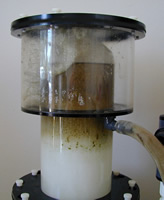 (image
left). This organic sludge is what the skimmer removes from
the water and this material shouldn't be allowed to fall back
into the water. Clean the air valves often, and remove any
built-up salt crust or particulate matter clogging the air
intake. Also, be aware that small snails and rock fragments
may become caught in the restrictions of many venturi valves
and pump intakes and must be removed if the skimmer is to
perform at peak efficiency. If airstones and an air pump are
being used, ensure its bubble production is optimal, replace
the airstone at regular monthly or bimonthly intervals and
check the air pump diaphragm to ensure maximal air is being
produced. Deep skimmers require consistently high pressure
from the pump diaphragm to work properly. If the skimmer requires
a water pump to generate bubbles, make certain the pump drives
the venturi or other air injection device at maximum efficiency;
weak pumps cause skimmers to work poorly. (image
left). This organic sludge is what the skimmer removes from
the water and this material shouldn't be allowed to fall back
into the water. Clean the air valves often, and remove any
built-up salt crust or particulate matter clogging the air
intake. Also, be aware that small snails and rock fragments
may become caught in the restrictions of many venturi valves
and pump intakes and must be removed if the skimmer is to
perform at peak efficiency. If airstones and an air pump are
being used, ensure its bubble production is optimal, replace
the airstone at regular monthly or bimonthly intervals and
check the air pump diaphragm to ensure maximal air is being
produced. Deep skimmers require consistently high pressure
from the pump diaphragm to work properly. If the skimmer requires
a water pump to generate bubbles, make certain the pump drives
the venturi or other air injection device at maximum efficiency;
weak pumps cause skimmers to work poorly.
In Summary
Protein skimmers can be an effective method
in reducing the problems related to waste accumulation in
our tanks. The application of skimmers have been associated
with reduced waste (reduction of DOCs), reduced algal growth,
and increased water quality. Many of the present  skimmers
on the hobbyist market are too small (height and diameter)
and/or underpowered to effectively remove sufficient amounts
of organic waste. As a rule of thumb, taller skimmers tend
to work better than short, squat ones. The hobbyist needs
to ensure bubble production is maximized (smaller bubbles
work better than big bubbles), and consequently, the water
in the reaction column should be milky white in appearance.
The foam produced in the skimmer should be continually moving
up towards the collection cup so that is being collected and
removed from the system. One final word on skimmate consistency:
this topic is often a subject of debate (i.e., thick, mud
colored, and dry versus watery and iced-tea colored (image
above right)), and it would bear further discussion in another
article. I'll leave the topic for now by saying: you want
to collect skimmate (any skimmate), and any skimmate is better
than no skimmate at all. skimmers
on the hobbyist market are too small (height and diameter)
and/or underpowered to effectively remove sufficient amounts
of organic waste. As a rule of thumb, taller skimmers tend
to work better than short, squat ones. The hobbyist needs
to ensure bubble production is maximized (smaller bubbles
work better than big bubbles), and consequently, the water
in the reaction column should be milky white in appearance.
The foam produced in the skimmer should be continually moving
up towards the collection cup so that is being collected and
removed from the system. One final word on skimmate consistency:
this topic is often a subject of debate (i.e., thick, mud
colored, and dry versus watery and iced-tea colored (image
above right)), and it would bear further discussion in another
article. I'll leave the topic for now by saying: you want
to collect skimmate (any skimmate), and any skimmate is better
than no skimmate at all.
For additional infomation see: www.proteinskimmers.com
|

